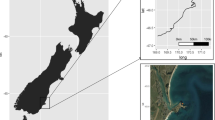Abstract
Energy budgets were determined for small pieces (nubbins) of the coralsPocillopora damicornis, Montipora verrucosa andPorites lobata living at a water depth of 3 m on the fringing reef of Coconut Island, Kaneohe, Hawaii. The budgets were determined for three different types of day: an “ideal” day with no cloud and an in situ daily integrated irradiance at 3 m of 14.385 E m−2 d−1; a “normal” day with sporadic cloud cover and daily irradiance of 11.915 E m−2 d−1; and an “overcast” day with daily irradiance of 6.128 E m−2 d−1. On the “ideal” day, the energy fixed in photosynthesis was more than that required for respiration and growth of both zooxanthellae and animal components of the association, and there was a predicted loss of between 19.3 and 32.4% of the energy fixed. On a “normal” day, the total photosynthetic energy fixation was lower and the excess was between 12.1 and 27.9% of the energy fixed. On the “overcast” day, however, in bothPocillopora damicornis andPorites lobata energy expenditure exceeded photosynthetic energy fixation and the budget was in deficit. Estimates of rate of mucus secretion on an “overcast” day were derived and, when incorporated into the energy budget, it was predicted that all three species would have a deficit budget, necessitating the catabolism of lipid reserves. From published values for lipid storage in these species it was calculated that the reserves would last from 28 d inPocillopora damicornis to 114 d inM. verrucosa. A model is suggested in which corals draw upon their extensive lipid stores on days of sub-optimal light, replenishing the reserves again when daily light levels are high, and finally excreting the excess energy fixed, as mucus-lipid when the lipid stores are replete.
Similar content being viewed by others
Literature cited
Basham, J. A., Buchanan, B. B. (1982). Carbon dioxide fixation pathways in plants and bacteria. In: Govindjee, A. (ed.) Photosynthesis. Vol. II. Academic Press, New York, p. 141–189
Birkeland, C. (1976). An experimental method of studying corals during early stages of growth. Micronesica 12: 319–322
Chalker, B. E. (1981). Simulating light-saturation curves for photosynthesis and calcification by reef-building corals. Mar. Biol. 63: 135–141
Chalker, B. E., Dunlap, W. C., Oliver, J. K. (1983). Bathymetric adaptations of reef-building corals at Davies Reef, Great Barrier Reef, Australia. II. Light saturation curves for photosynthesis and respiration. J. exp. mar. Biol. Ecol. 73: 37–56
Crossland, C. J. (1987). In situ release of mucus and DOC-lipid from the coralsAcropora variabilis andStylophora pistillata in different light regimes. Coral Reefs 6: 35–42
Crossland, C. J., Barnes, D. L., Borowitzka, M. A. (1980). Diurnal lipid and mucus production in the staghorn coralAcropora acuminata. Mar. Biol. 60: 81–90
Davies, P. S. (1980). Respiration in some Atlantic reef corals in relation to vertical distribution and growth form. Biol. Bull. mar. biol. Lab., Woods Hole 158: 187–194
Davies, P. S. (1984). The role of zooxanthellae in the nutritional energy requirements ofPocillopora eydouxi. Coral Reefs 2: 181–186
Davies, P. S. (1989). Short-term growth measurements of corals using an accurate buoyant weighing technique. Mar. Biol. 101: 389–395
Edmunds, P. J., Davies, P. S. (1986). An energy budget forPorites porites (Scleractinia). Mar. Biol. 92: 339–347
Edmunds, P. J., Davies, P. S. (1988). Post-illumination stimulation of respiration rate in the coralPorites porites. Coral Reefs 7: 7–9
Elliot, J. M., Davison, W. (1975). Energy equivalents of oxygen consumption in animal energetics. Oecologia 18: 195–201
Fruton, I. S., Simmonds, S. (1958). General biochemistry. John Wiley & Sons, New York
Giese, A. C. (1973). Cell physiology. Saunders, Philadelphia
Hoegh-Guldberg, O., McCloskey, L. R., Muscatine, L. (1987). Expulsion of zooxanthellae by symbiotic cnidarians from the Red Sea. Coral Reefs 5: 201–204
Jokiel, R. L., Maragos, J. E., Franzisket, L. (1978). Coral growth: buoyant weight technique. Monogr. oceanogr. Methodol. (UNESCO) 5: 529–542
McCloskey, L. R., Muscatine, L. (1984). Production and respiration in the Red Sea coralStylophora pistillata as a function of depth. Proc. R. Soc. (Ser. B) 222: 215–230
Muscatine, L. (1967). Glycerol excretion by symbiotic algae from corals andTridacna and its control by the host. Science, N.Y. 156: 516–519
Muscatine, L., Cernichiari, E. (1969). Assimilation of photosynthetic products of zooxanthellae by a reef coral. Biol. Bull. mar. biol. Lab., Woods Hole 137: 506–523
Muscatine, L., Falkowski, P. G., Porter, J. W., Dubinsky, Z. (1984). Fate of photosynthetically fixed carbon in light- and shadeadapted colonies of the symbiotic coralStylophora pistillata. Proc. R. Soc. (Ser. B) 222: 181–202
Muscatine, L., McCloskey, L. R., Loya, Y. (1985). A comparison of the growth rates of zooxanthellae and animal tissue in the Red Sea coralStylophora pistillata. Proc 5th int. coral Reef Congr. 6: 119–123 [Gabrie, C. et al. (eds.) Antenne Museum-EPHE, Moorea, French Polynesia]
Patton, J. S., Abraham, S., Benson, A. A. (1977). Lipogenesis in the intact coralPocillopora capitata and its isolated zooxanthellae: evidence for a light-driven carbon cycle between symbiont and host. Mar. Biol. 44: 235–247
Patton, J. S., Burris, J. E. (1983). Lipid synthesis and extrusion by freshly isolated zooxanthellae (symbiotic algae). Mar. Biol. 75: 131–136
Porter, J. W. (1976). Autotrophy, heterotrophy and resource partitioning in Caribbean reef-building corals. Am. Nat. 110: 731–742
Richmond, R. H. (1987). Energetic relationships and biogeographical differences among fecundity, growth and reproduction in the reef coralPocillopora damicornis. Bull. mar. Sci. 41: 594–604
Stimson, J. S. (1987). Location, quantity and rate of change in quantity of lipids in tissue of Hawaiian hermatypic corals. Bull. mar. Sci. 41: 889–904
Tytler, E. M., Davies, P. S. (1986). The budget of photosynthetically derived energy in theAnemonia sulcata (Pennant) symbiosis. J. exp. mar. Biol. Ecol. 99: 257–269
Author information
Authors and Affiliations
Additional information
Communicated by J. Mauchline, Oban
Rights and permissions
About this article
Cite this article
Davies, P.S. Effect of daylight variations on the energy budgets of shallow-water corals. Mar. Biol. 108, 137–144 (1991). https://doi.org/10.1007/BF01313481
Accepted:
Issue Date:
DOI: https://doi.org/10.1007/BF01313481




